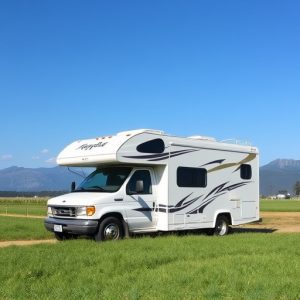Navigating RV Weight Limits for Safer Towing and Travel
Before hitting the road in your RV, it's crucial to understand the weight classes and towing c…….

Before hitting the road in your RV, it's crucial to understand the weight classes and towing capacities to ensure a safe journey. Each RV class from A to B determines its physical size and the type of tow vehicle needed, with Class A motorhomes requiring heavy-duty trucks due to their weights exceeding 20,000 pounds, while Class B camper vans need less powerful tow vehicles that align with their lighter loads. Safety in RV towing involves recognizing key weight ratings like the Gross Vehicle Weight Rating (GVWR) and the Gross Combination Weight Rating (GCWR), which together dictate the total weight of the RV, its cargo, passengers, and the tow vehicle. Adhering to these limits is vital for the longevity of your vehicles, road safety, and the well-being of all passengers.
RV travel tips emphasize consulting owner's manuals for precise weight ratings and seeking professional advice when necessary to avoid overloading. Understanding the Unloaded Vehicle Weight, which sets the base for your RV's capacity, is essential, as well as knowing the GVWR, which includes all passengers, cargo, fluids, and equipment. Regular weigh-ins at appropriate scales are recommended to ensure your RV's payload stays within safe parameters for optimal handling and safety. Proper load management, choosing the right hitch type, vigilant driving, consistent maintenance, and compliance with towing laws are all part of responsible RV travel planning.
By heeding these RV travel tips, you can safeguard your trip, adhere to regulations, and enhance your experience with the freedom and adventure that RV travel provides. Remember, safe RV travel is about understanding your vehicle's weight specifications, managing your load effectively, and being prepared for any situation on the road.
Embarking on an RV adventure requires meticulous planning, especially when it comes to understanding RV weight limits for safe towing. This article demystifies the complexities of RV weight classes and provides actionable RV travel tips to ensure your journey is as smooth as the open road itself. From decoding the unloaded vehicle weight to mastering load distribution and hitches, we’ll guide you through the key components of RV weight, culminating in practical advice for safe driving considerations. Join us to navigate your RV travels with confidence and security.
- Decoding RV Weight Classes for Safer Towing Experiences
- Key Components of RV Weight: Understanding Unloaded Vehicle Weight, Gross Vehicle Weight Rating (GVWR), and Curb Weight
- Practical RV Travel Tips: Load Distribution, Hitches, and Safe Driving Considerations
Decoding RV Weight Classes for Safer Towing Experiences

When planning an RV travel adventure, understanding the weight classes of your recreational vehicle is paramount for a safe towing experience. RVs come in various sizes and weights, categorized into different classes that not only dictate their size but also influence the type of tow vehicle required. Class A motorhomes, often built on truck chassis, can weigh upwards of 20,000 pounds and beyond, making them suitable for heavy-duty trucks designed for towing such massive vehicles. On the other hand, smaller Class B camper vans, which are essentially converted vans, typically weigh less and can be towed by a wide range of vehicles, provided the weight limits align with the capabilities of the tow vehicle. Understanding these weight classes helps ensure that you match your RV with an appropriate tow vehicle, one that can handle the load without compromising safety or exceeding its own capacity. This balance is crucial to manage the handling and performance of the towed RV, especially on long trips or challenging terrain.
To tow your RV safely, it’s essential to know the specific weight ratings of both your RV and your tow vehicle. These include the Gross Vehicle Weight Rating (GVWR) and the Gross Combination Weight Rating (GCWR). The GVWR is the maximum loaded weight of the RV when it’s fully fueled, equipped with cargo, passengers, and optional equipment. The GCWR takes into account not just the RV but also the weight of whatever you’re towing, such as a car or another trailer, in addition to the cumulative weight of the tow vehicle and the RV. Adhering to these weight limits is not just about following guidelines; it’s about ensuring the longevity of your vehicles, maintaining control on the road, and most importantly, safeguarding the well-being of everyone on board. Always consult the owner’s manuals for precise figures and RV travel tips that emphasize safety overload, and when in doubt, seek professional advice to make informed decisions about your RV travel plans.
Key Components of RV Weight: Understanding Unloaded Vehicle Weight, Gross Vehicle Weight Rating (GVWR), and Curb Weight

When embarking on an RV travel adventure, it’s crucial to grasp the key components of your vehicle’s weight specifications to ensure a safe and enjoyable journey. The Unloaded Vehicle Weight, also known as the dry weight or base weight, is the heft of the RV without any cargo, passengers, fluids, or optional equipment installed. This initial figure sets the baseline for understanding the RV’s structure and capacity, allowing for informed decisions about payload capacity.
Moving forward to the Gross Vehicle Weight Rating (GVWR), this figure represents the maximum loaded weight of the RV, including all occupants, cargo, and fluids. It’s a critical threshold that informs you of the maximum weight your RV can safely operate at, ensuring it doesn’t exceed its structural limits. Staying below the GVWR is essential for preserving the integrity of the vehicle and maintaining control on the road. Additionally, understanding your RV’s Curb Weight, which includes only the truck chassis, RV body, engine, and base fuel tank when empty, is vital for calculating how much weight you can safely add without surpassing the GVWR. By knowing these weight limits, you can efficiently pack, distribute cargo evenly, and load gear, which contributes to better handling and a safer travel experience. RV Travel Tips emphasize regular weigh-ins at scales designed for oversized vehicles to ensure your RV’s payload is within safe limits. Adhering to these guidelines not only enhances the longevity of your vehicle but also provides peace of mind for every mile on the open road.
Practical RV Travel Tips: Load Distribution, Hitches, and Safe Driving Considerations

When embarking on an RV journey, understanding and adhering to weight limits is paramount for safe towing and travel. The distribution of load within the RV and the choice of hitch type are critical factors that contribute to a secure and efficient trip. Proper load distribution involves strategically placing heavier items lower and closer to the axles at the center of the RV to optimize stability and handling. This not only reduces wear and tear on the vehicle but also minimizes the risk of tipping or swaying, which can be particularly hazardous at high speeds or during adverse weather conditions. Additionally, selecting the appropriate hitch for your RV and tow vehicle is essential; different hitches are designed to handle varying weights and types of loads, so it’s important to match the hitch to the specific weight distribution of your setup.
Safe driving considerations extend beyond the initial setup. Drivers must be mindful of their surroundings, adjusting speed and maneuvering to accommodate the size and weight of the RV. Regular maintenance checks are also a part of responsible RV travel; ensuring that brakes, tires, and all other components are in optimal condition is crucial for safety on the road. Furthermore, understanding the specific towing laws and regulations of each state or region you’ll be traveling through will help prevent fines and legal issues. By combining practical RV travel tips with careful planning and attention to detail, you can ensure a safer, more enjoyable journey, making the most of your RV travel experience.







